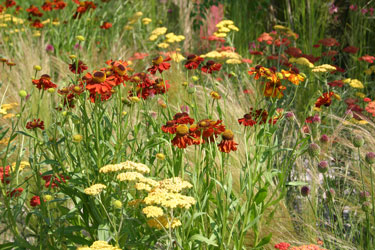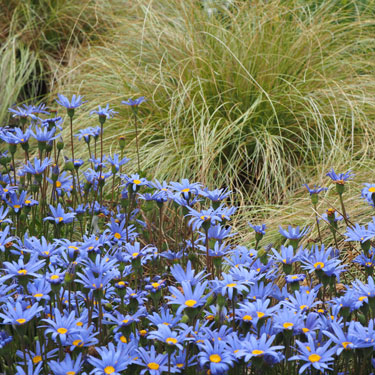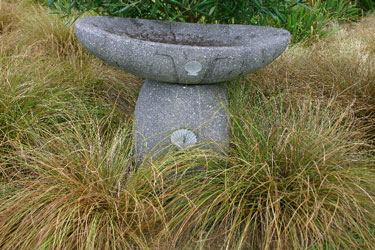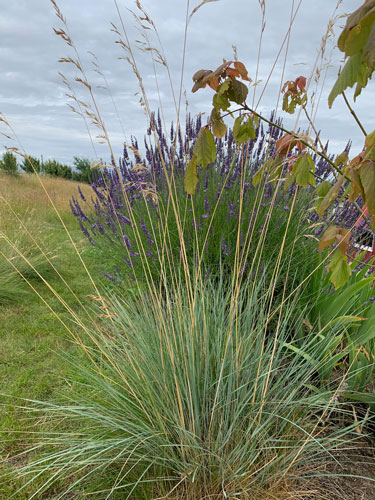Grow grasses for grace and function
Grasses and grass-like plants present a luminous array of oranges, golds, browns, reds, silvery blues and greens, and growth habits that range from short and spiky to graceful and fluid. They’re among the best ever plants for adding permanent contrasts of colour or texture. Unique flowers and seed heads are a seasonal bonus.
Fine silky strands sparkling in the sun look especially good with broad leaf plants. And, dancing in the lightest breeze, grasses are a perfect foil for stationary objects such as sculpture and rocks. Combine grasses with spiky foliage and flaxes, or with tall flowers for a wilderness look. Compact varieties make useful groundcovers and are often used as edging.
On a dry windswept site, an entire garden of grasses will set the stage for a dramatic view or bold architecture. Key to Japanese gardens, grasses also work beautifully with water. Grasses also look superb in pots, the dry-loving varieties being particularly well suited.
New Zealand native grasses and grass-like plants have become international favourites. While our native varieties are prized in overseas gardens, we also have a wonderful range of imported varieties at our disposal.
There is a beautiful ornamental grass for almost any situation, but beware of those attractive imports that threaten our native habitats. Some grasses are rhizomatous, or “running”, meaning they spread by underground stems. Such plants can make useful ground covers or help with erosion control and will resist weed invasion, but they may also take over your garden! Clump forming grasses simply get bigger in circumference each year, without invasive roots, but they do need lifting and dividing every few years.
A few once-popular exotics, with either invasive rhizomes, or overbearing self-seeding, are now listed as plant pests in New Zealand, but there are plenty of other well-behaved grasses to choose from.
Location, location
Selecting grasses that suit your soil and climate is the best recipe for success. For example, native tussocks from dry alpine climates with gravelly soils may not last long in rich soil with high humidity. Subtropical exotics, such as mondo grass and the Australian Lomandra varieties are very successful in our warmer climates.
Grasses for damp but well drained soil
Chionochloa rubra - red tussock
Chionochloa flavicans
Hakonechloa macra ‘Aureola’
Imperata cylindrica ‘Rubra’
Machaerina sinclairii
Grasses for wet ground
Acorus gramineus ‘Ogon’
Carex secta
Carex dipsacea
Cortaderia fulvida - toetoe
Cyperus involucratus - umbrella grass
Miscanthus sinensis ‘Zebrinus’ - zebra grass
Restio tetraphyllus - plume rush
Grasses for dry places
Anemanthele lessoniana - gossamer grass
Carex comans
Carex testacea
Carex tenuiculmis
Festuca coxii - Chatham Island blue grass
Festuca novae-zelandiae
Helictotrichon sempervirens - blue oat grass
Lomandra species
Poa cita - silver tussock
Grasses for shade
Acorus gramineus ‘Ogon’
Anemanthele lessoniana - gossamer grass
Chionochloa flavicans
Carex dipsacea
Carex hachijoensis ‘Evergold’ - Japanese sedge
Carex secta
Carex comans ‘Frosted Curls’
Lomandra species - mat rush
Luzula sylvatica ‘Marginata’
Machaerina sinclarii
Ophiopogon species - mondo grass
Poa anceps
Grasses for warm climates
Chionochloa species
Chondropetalum tectorum - thatching rush
Cortaderia fulvida - toetoe
Elegia cuspidata
Imperata cylindrica ‘Rubra’
Lomandra species - mat rush
Ophiopogon species - mondo grass
Grasses for cold climates
Carex species
Chionochloa rubra - red tussock
Cortaderia richardii - toetoe
Poa cita - silver tussock
Basic care for Grasses
Grasses are easy to grow, but a little pampering goes a long way. Plants that end up looking sad and shabby after a few years are usually the result of too much or too little water, or a less than ideal climate.
- Rake or comb with gloved hands to clear away dead foliage.
- Remove the flower heads of any self-seeders you want to keep under control.
- Untidy tussocks and deciduous grasses can be cut back close to the ground and they’ll come away again with renewed vigour in spring.
- Lift and divide every few springs to keep growth fresh and vigorous.
How to divide ornamental grasses
You will need: Depending on the scale and age of your grass, you’ll need a sharp spade or shovel and a knife, possibly an axe or even a chain saw or crow bar! You’ll also need some shears.
- Dig around the plant allowing as much root ball as practical and lift it out of the ground.
- Divide the clump into sections using a knife, a saw or a chainsaw.
- Trim the foliage back by one-quarter to one-third of its original height.
- Replant the divisions as soon as possible, to prevent moisture loss.

4-Jan-2023

Achillea and Helianthemum growing with grasses

Felicia Santa Anita growing with native grasses.

Carex species soften the setting for a stone birdbath.

Blue Oat Grass, Helictotrichon

